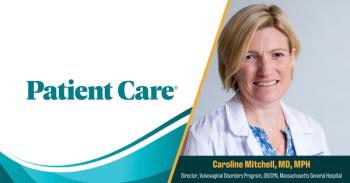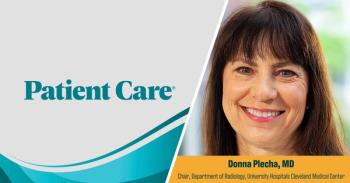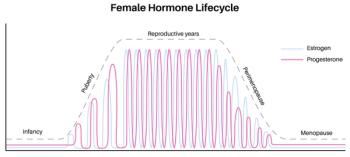
Coronary Heart Disease and Dyslipidemia
ABSTRACT: Lipid abnormalities are extremely prevalent among the elderly, a group at very high risk for cardiovascular disorders. Accordingly, the treatment guidelines of the National Cholesterol Education Program Adult Treatment Panel do not suggest that lipid management be any less aggressive in older patients than in younger ones. Management decisions focus on the calculated low-density lipoprotein cholesterol level as part of a full fasting lipid panel. Dietary counseling remains an important element in the management of lipid disorders, but almost all elderly patients require medications to reach their lipid goals. The statins are the mainstay of treatment for most patients, but some will require additional agents, such as a fibrate, niacin, ezetimibe, fish oil, or a bile acid sequestrant.
Cardiovascular disease is by far the leading cause of death among the elderly, accounting for half or more of all deaths in this age group. Indeed, well over half of the coronary deaths in the United States occur in those who are older than 65 years.
In the past, some experts were skeptical of the value of aggressive lipid lowering in the elderly,1 but the overwhelming bulk of evidence in recent years strongly supports aggressive management in this age group. In fact, the current lipid treatment guidelines promulgated by the National Cholesterol Education Program Adult Treatment Panel do not distinguish at all between younger and older patients in terms of how aggressive therapy should be.2,3 I will discuss these guidelines in detail later in this article; I will also examine the evidence supporting aggressive lipid management and describe effective interventions.
THE CASE FOR AGGRESSIVE LIPID MANAGEMENT
Earlier studies. It has been recognized for years that both low high-density lipoprotein cholesterol (HDL-C) levels and high low-density lipoprotein cholesterol (LDL-C) levels are risk factors for cardiovascular events in the elderly.4 A meta-analysis showed a definite association between elevated cholesterol levels and increased cardiac morbidity in those aged 65 and older.5 Moreover, in an observational survey, Barrett-Connor and coworkers6 found that the total cholesterol level is an important risk factor for cardiovascular disease in the elderly. Similarly, Rubin and associates,7 Benfante and Reed,8 and Aronow and colleagues9 reported that lipid levels correlate directly with cardiovascular risk in the elderly. To be sure, all these studies are epidemiologic and cross-sectional, in contrast to the more powerful prospective data derived from more recent randomized, controlled trials.
Heart Protection Study. Several major prospective studies have now confirmed that lowering LDL-C significantly reduces cardiac morbidity and mortality in the elderly. A large study that confirmed the value of using statin therapy to lower LDL-C levels in both primary and secondary prevention settings was the Heart Protection Study.10 A total of 20,536 adults in the United Kingdom, aged 40 to 80 years, were randomized to receive either simvastatin (40 mg/d) or placebo. Of these patients, 28% were aged 70 to 80 years.
The subgroup analysis confirmed that participants aged 70 years or older received as large a proportional benefit--an average 34% reduction in cardiovascular events--as did those who were younger. Another interesting finding from the Heart Protection Study was that the baseline LDL-C level did not predict the relative degree of benefit from statin therapy; the proportional reduction in event rate was similar in participants who had relatively low initial levels of LDL-C (below 100 mg/dL) and in those who started out with higher levels. This suggests that much of the benefit derived from statin therapy may not relate directly to LDL lowering, but rather to the so-called pleiotropic effects of statins, which enhance vasodilatation, inhibit thrombus formation, and reduce the levels of inflammatory substances, such as cytokines and C-reactive protein.
PROSPER. Another important trial of LDL lowering in the elderly was the Prospective Study of Pravastatin in the Elderly at Risk (PROSPER), which was conducted specifically to examine the potential benefits of statin therapy in older adults.11 A total of 5804 men and women, aged 70 to 82 years (mean age, 75.3 years), were randomized to receive either pravastatin (40 mg/d) or placebo. All participants either had a history of atherosclerosis or had risk factors for atherosclerosis.
The patients who received pravastatin had a reduction of 34% in LDL-C levels, a reduction of 13% in triglyceride levels, and an increase of 5% in HDL-C levels. These changes translated into a statistically significant 15% reduction in the primary end point of the study, which was a composite of coronary death, nonfatal myocardial infarction (MI), and fatal or nonfatal stroke. There was no reduction in cerebrovascular events, which may conceivably require a longer period of therapy than the mean follow-up of 3.2 years in the PROSPER study.
CARDS. Another trial that demonstrated the benefit of lipid lowering in older adults was the Collaborative Atorvastatin Diabetes Study (CARDS), which was specifically designed to look at whether statins should be used for primary prevention in persons with type 2 diabetes.12 A total of 2838 patients with type 2 diabetes who had not experienced a vascular event were recruited into the trial, which was conducted in the United Kingdom and in Ireland. Of these participants, 50% were between the ages of 60 and 70, which reflects the fact that most persons with type 2 diabetes tend to be older; an additional 12% were over the age of 70. All were randomized to receive either atorvastatin (10 mg/d) or placebo.
The primary end point was the time to the first major cardiovascular event, which included coronary angina, resuscitated cardiac arrest, coronary revascularization, and stroke. Among the patients who took atorvastatin, the overall reduction in cardiovascular events was 37%. The risk reduction was roughly equal across all age strata.
NCEP TREATMENT GUIDELINES
The treatment guidelines of the National Cholesterol Education Program (NCEP) Adult Treatment Panel III are the closest to a national consensus on the management of lipid disorders; the most recent complete set was published in 2001,2 with a supplemental set of recommendations added in 2004.3 Note that these guidelines do not suggest that lipid management in older patients be any less aggressive than in younger persons. There is no age adjustment of any sort in the NECP recommendations.
The guidelines recommend measurement of serum cholesterol levels--including HDL level--at least once every 5 years in all adults aged 20 years and older. The screening measurements of total cholesterol and HDL levels do not require fasting, which facilitates their collection.
The 2001 NCEP treatment recommendations were made more aggressive by the update published in 2004 (Table). For high-risk patients--defined as those with known coronary heart disease (CHD), cerebrovascular disease, peripheral arterial disease, or diabetes, which is considered a cardiac risk equivalent--the overall LDL goal remains under 100 mg/dL. However, for very high-risk patients--such as those with a recent MI or those who have known cardiovascular disease coupled with diabetes, severe or poorly controlled risk factors such as continued smoking, or metabolic syndrome--the optional LDL goal is under 70 mg/dL. For moderately high-risk patients--defined as those without evidence of cardiovascular disease but with 2 or more CHD risk factors, who thus have a 10% to 20% risk of an MI within 10 years--the treatment goal is an LDL level of less than 130 mg/dL. For those at only moderate risk--defined as having 2 or more risk factors but a less than 10% risk of MI within 10 years--the LDL goal is less than 160 mg/dL.
DIETARY THERAPY
The initial dietary treatment for dyslipidemia is the Step I Diet, which is identical to the Prudent Heart Diet recommended by the American Heart Association for all persons. The Step I Diet restricts daily fat intake to less than 30% of total calories, cholesterol to less than 300 mg, and saturated fat to 10% or less of total calories. In addition, the diet allows polyunsaturated fats to constitute a maximum of 10% of total calories.
It is important that elderly patients not become malnourished while they are on this lipid-lowering diet. Monitor the patient's overall nutrition, preferably with the assistance of a registered dietitian. Higher-risk patients should be treated initially with medication as well as dietary therapy.
Some compliant elderly patients who have not achieved their lipid goals after 3 to 4 months of the Step I Diet may require the Step II Diet. But compliance is often difficult with the more rigid Step II Diet, especially for older patients. It restricts saturated fat intake to 20% or less of total calories; total dietary cholesterol cannot exceed 200 mg.
DRUG THERAPY
Statins. The statins remain the most commonly prescribed lipid-lowering medications because of their proven ability to reduce LDL-C levels and because many clinical trials have shown that they also reduce morbidity and mortality. These drugs are reasonably effective at lowering triglyceride levels, and they generally do so in proportion to the degree of LDL lowering that is achieved. However, the statins produce only modest elevations in HDL-C levels.
Fibrates. The fibric acid derivatives (fibrates) are widely prescribed for persons with elevated triglyceride or decreased HDL-C levels. The outcomes data are more impressive for the older fibrate, gemfibrozil, than for the newer and much more widely used agent, fenofibrate. Fenofibrate was perceived to be less likely to elevate LDL-C than gemfibrozil. Nonetheless, gemfibrozil has more impressive outcomes data, specifically from two important trials, the Helsinki Heart Study13 and the Veterans Affairs High-Density Lipoprotein Intervention Trial (VA-HIT).14 Both studies showed clear reductions in cardiovascular morbidity and mortality when gemfibrozil was added to existing therapy.
In contrast, the largest study conducted with fenofibrate, the Fenofibrate Intervention and Event Lowering in Diabetes (FIELD) study,15 produced equivocal results when fenofibrate was added to existing therapy in a large cohort of patients with type 2 diabetes. The primary end point showed a statistical trend favoring fenofibrate, but statistical significance was not achieved. Several less definitive secondary end points did achieve statistical significance. There were a number of methodological problems, such as a high rate of drop-in statin use in the placebo wing; nonetheless, the overall results were disappointing.
Niacin. Nicotinic acid (niacin) is an extremely potent drug that lowers levels of total cholesterol, LDL-C, triglycerides, and Lp(a) lipoprotein and significantly increases HDL-C levels. The magnitude of these changes is usually directly proportional to the dosage. Unfortunately, niacin can be challenging to use because of its side effects. Virtually all patients who receive niacin experience severe flushing 20 to 30 minutes after a dose. This flushing usually fades in intensity over several weeks, but many patients are unwilling to tolerate the effect for that period. Niacin can also exacerbate diabetes and gout and can produce unpleasant GI symptoms, such as dyspepsia or nausea. More serious side effects, such as major liver damage, are seen much less frequently.
Avoid sustained-release niacin because the risk of serious, even fatal, hepatotoxicity is considerably higher with this form of the drug. A prescription formulation of intermediate-release niacin is available. This product does not produce hepatotoxicity, but it is associated with some degree of initial flushing in most patients. Despite the problems associated with niacin, it remains a useful medication in compliant older patients who have been informed of the potential side effects.
Ezetimibe. There are currently no outcomes data that support the use of ezetimibe. This agent blocks the absorption of cholesterol in the small intestine; thus, it can be readily used in combination with statins to produce additional lipid lowering. Because only minimal amounts of the drug are absorbed systemically, the side effect profile is remarkably benign. However, the lack of outcomes data has caused some experts to worry that ezetimibe may not produce the same reduction in cardiovascular risk for a given achieved LDL-C level as the statins, since the pleiotropic effects of the latter medications are believed to augment their LDL-lowering benefits.
Fish oil. A standardized, FDA-approved formulation of omega-3 fish oils is available. The product is a highly concentrated and purified preparation that contains 2 important omega-3 fish oils, eicosapentaenoic acid (EPA) and docosahexaenoic acid. The main value of fish oil is in patients with persistently elevated triglyceride levels that have proved refractory to more conventional triglyceride-lowering therapies, such as statins, fibrates, and niacin, alone or in combination. There are only limited outcomes data for the use of fish oils to reduce cardiac risk. The largest trial, the Japan EPA Lipid Intervention Study (JELIS),16 used a preparation that contained only EPA; a modest but statistically significant reduction in cardiovascular risk was seen when the fish oil preparation was added to statin therapy.
Bile acid sequestrants. These are infrequently used today because of their relatively unfavorable side effect profile. These agents, which include cholestyramine, colestipol, and colesevelam, tend to cause constipation, abdominal fullness and bloating, and abdominal heaviness. They may also produce an increase in triglyceride levels. They are infrequently used, usually in combination with other agents, in patients with refractory elevations of LDL-C levels.
Combination therapy. In recent years, combination therapy for lipid abnormalities has become more common. The combination of a fibrate and a statin is increasingly used despite the modest increase in the risk of rhabdomyolysis. The combination of ezetimibe and simvastatin is especially useful in treating patients with refractory elevations in their LDL-C levels.
References:
REFERENCES:
1.
Krumhulz HM, Seemen TE, Merrill SS, et al. Lack of association between cholesterol and coronary heart disease mortality and morbidity and all-cause mortality in persons older than 70 years.
JAMA.
1994;272:1335-1340.
2.
Expert Panel on Detection, Evaluation, and Treatment of High Blood Cholesterol in Adults. Executive Summary of the Third Report of the National Cholesterol Education Program (NCEP) Expert Panel on Detection, Evaluation, and Treatment of High Blood Cholesterol in Adults (Adult Treatment Panel III).
JAMA
. 2001;285:2486-2497.
3.
Grundy SM, Cleeman JI, Merz CN, et al. Implications of recent clinical trials for the National Cholesterol Education Program Adult Treatment Panel III guidelines.
Circulation.
2004;110:227-239.
4.
Zimetbaum P, Frishman WH, Ooi WL, et al. Plasma lipids and lipoproteins and the incidence of cardiovascular disease in the very elderly. The Bronx Aging Study.
Arterioscler Thromb
. 1992;12:416-423.
5.
Manolio TA, Pearson TA, Wenger NK, et al. Cholesterol and heart disease in older persons and women. Review of an NHLBI workshop.
Ann Epidemiol
. 1992;2:161-176.
6.
Barrett-Connor E, Suarez L, Khaw K, et al. Ischemic heart disease risk factors after age 50.
J Chron Dis.
1984;37:903-908.
7.
Rubin SM, Sidney S, Black DM, et al. High blood cholesterol in elderly men and the excess risk for coronary heart disease.
Ann Intern Med
. 1990;113: 916-920.
8.
Benfante R, Reed D. Is elevated serum cholesterol level a risk factor for coronary artery disease in the elderly?
JAMA
. 1990;263:393-396.
9.
Aronow WS, Herzig AH, Etienne F, et al. 41-month follow-up of risk factors correlated with new coronary events in 708 elderly patients.
J Am Geriatr Soc
. 1989; 37:501-506.
10.
Heart Protection Study Collaborative Group. MRC/BHF Heart Protection Study of cholesterol lowering with simvastatin in 20,536 high-risk individuals: randomized placebo-controlled trial.
Lancet
. 2002;360:7-22.
11.
Shepherd, J, Blauw GJ, Murphy MB, et al. Pravastatin in elderly individuals at risk for vascular disease (PROSPER): a randomized controlled trial.
Lancet
. 2002;360:1623-1630.
12.
Colhoun HM, Betteridge DJ, Durrington PN, et al. Primary prevention of cardiovascular disease with atorvastatin in type 2 diabetes in the Collaborative Atorvastatin Diabetes Study (CARDS): a multicentre randomised placebo-controlled trial.
Lancet
. 2004;364:685-696.
13.
Frick MH, Elo O, Haapa K, et al. Helsinki Heart Study: primary-prevention trial with gemfibrozil in middle-aged men with dyslipidemia. Safety of treatment, changes in risk factors, and incidence of coronary heart disease
. N Engl J Med
. 1987;317:1237-1245.
14.
Rubins HB, Robins SJ, Collins D, et al. Gemfibrozil for the secondary prevention of coronary heart disease in men with low levels of high-density lipoprotein cholesterol. Veterans Affairs High-Density Lipoprotein Cholesterol Intervention Trial Study Group
.
N Engl J Med.
1999;341:410-418.
15.
Keech A, Simes RJ, Barter P, et al. Effects of long-term fenofibrate therapy on cardiovascular events in 9795 people with type 2 diabetes mellitus (the FIELD Study): randomized controlled trial.
Lancet
. 2005;366:1849-1861.
16.
Yokoyama M. Effects of eicosapentaenoic acid (EPA) on major cardiovascular events in hypercholesterolemia patients: The Japan EPA Lipid Intervention Study (JELIS). Paper presented at: American Heart Association Scientific Sessions; November 13-16, 2005; Dallas.
RELEVANT GUIDELINES
- Expert Panel on Detection, Evaluation, and Treatmentof High Blood Cholesterol in Adults. Executive
- Summary of the Third Report of the National CholesterolEducation Program (NCEP) Expert Panelon Detection, Evaluation, and Treatment of HighBlood Cholesterol in Adults (Adult Treatment PanelIII). JAMA. 2001;285:2486-2497.
- Grundy SM, Cleeman JI, Merz CN, et al. Implicationsof recent clinical trials for the National CholesterolEducation Program Adult Treatment Panel IIIguidelines. Circulation. 2004;110:227-239.
Newsletter
Enhance your clinical practice with the Patient Care newsletter, offering the latest evidence-based guidelines, diagnostic insights, and treatment strategies for primary care physicians.

























































































































































































































































































